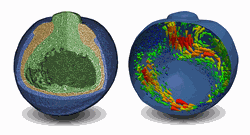An international team of scientists using a new X-ray method recorded the internal structure and cell movement inside a living frog embryo in greater detail than ever before.
This result showcases a new method to advance biological research and the search for new treatments for genetic diseases.
Scientists at Northwestern University and the Karlsruher Institut für Technologie in Germany, in collaboration with the Advanced Photon Source at the U.S. Department of Energy Argonne National Laboratory, released the most precise depiction ever of the embryonic development of African clawed frogs, one of the most frequently studied model organisms in biology.
The results titled “X-ray phase-contrast in vivo microtomography probes new aspects of Xenopus gastrulation” were published May 16 in the journal Nature.
The team X-rayed an embryo during gastrulation, the period when its hundreds of cells start to organize into differentiated tissues that eventually form the nervous system, muscles, and internal organs. Studies of African clawed frog embryos can provide clues to the evolution of vertebrates and how human genes turn on or off to create diseases.
Until now, however, it has been difficult to study these embryos. Classical absorption imaging requires a contrast agent and large X-ray dose that can harm living organisms. Researchers from the German synchrotron ANKA proposed a new method of nondestructive analysis using X-ray diffraction. The work was done at the APS outside Chicago because the APS’s high-energy X-rays were required to prevent blurring of the image and damage to the sensitive embryos.
“To obtain the best possible results, a highly coherent high-energy X-ray source with high flux is necessary,” says Xianghui Xiao, a scientist at the APS who collaborated on the work. “The APS is one of only a few X-ray light sources in the world with this capability. The upgrade of the APS will further improve our ability to study the real-time movement of molecules in living organisms.”
In the experiment, Xiao and his colleagues took regular 15-second exposures separated by periods of 10 minutes over the course of two hours of different gastrulas. The resulting 13 time-lapse scans provided a detailed portrait of the transfiguration of the frog cells.
The scientists discovered new morphological structures and clarified the process for redistributing fluid in the embryo. They also were able to locate the areas of the embryo that were driving the migration of tissues and cells during gastrulation.
“X-ray diffraction enables high-resolution imaging of soft tissues,” says Ralf Hofmann, one author of the study and a physicist at the Karlsruhe Institute of Technology in Germany. “In our work, we did not only mange to resolve individual cells and parts of their structure, but we could also analyze single cell migration, as well as the movement of cellular networks.”
The original Argonne National Laboratory press release by Jared Sagoff can be read here.
The Advanced Photon Source at Argonne National Laboratory is one of five national synchrotron radiation light sources supported by the U.S. Department of Energy’s Office of Science to carry out applied and basic research to understand, predict, and ultimately control matter and energy at the electronic, atomic, and molecular levels, provide the foundations for new energy technologies, and support DOE missions in energy, environment, and national security. To learn more about the Office of Science x-ray user facilities, visit http://science.energy.gov/user-facilities/basic-energy-sciences/.
Argonne National Laboratory seeks solutions to pressing national problems in science and technology. The nation's first national laboratory, Argonne conducts leading-edge basic and applied scientific research in virtually every scientific discipline. Argonne researchers work closely with researchers from hundreds of companies, universities, and federal, state and municipal agencies to help them solve their specific problems, advance America's scientific leadership and prepare the nation for a better future. With employees from more than 60 nations, Argonne is managed by UChicago Argonne, LLC for the U.S. Department of Energy's Office of Science.

